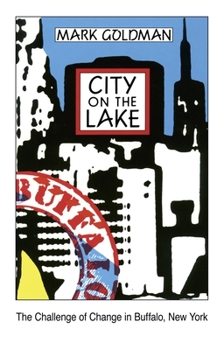City on the Lake: The Challenge of Change in Buffalo, New York
Select Format
Select Condition 
Book Overview
For more than a hundred years, Buffalo was one of the world's great industrial cities. Its grand office buildings and stately mansions overlooked a metropolis that was the eleventh largest industrial center in the United States, the third largest producer of steel, and the largest inland port. Its diverse ethnic heritage, represented by sizable enclaves of Irish, Italians, Poles, Jews, Germans, and African-Americans, gave the city a vibrant sense...
Format:Paperback
Language:English
ISBN:0879755792
ISBN13:9780879755799
Release Date:June 1990
Publisher:Prometheus Books
Length:324 Pages
Weight:1.04 lbs.
Dimensions:0.7" x 5.4" x 8.3"
Customer Reviews
3 ratings
Enjoyable Memories of Buffalo
Published by Thriftbooks.com User , 15 years ago
I was born on Davis St. on the East Side of Buffalo and attended St. Boniface Catholic School on Locust St in the Fruit Belt in the early fifties. I lived in Buffalo for 46 years before moving to Florida. My parents were German and Irish so I spent alot of time in South Buffalo as well where my father's family resided. The reason for the background is to set the stage for why I so enjoyed reading Mr. Goldman's book about a city that I will always treasure in my mind but regretfully wish sometimes that it had become something more today. For those that share a Buffalo heritage you should read this book because it will take you back to the days when the city was vibrant and so unique because of it's ethnic diversity. The book is not only enjoyable because of the history of the city and surrounding areas but Mr. Goldman is a very talented writer. His style has consistent segways from one topic to another, sometimes reversing in chronlogy, but never leaving you confused by the traverse through time. I'm finished with the book and intend to send it to my uncle who still lives outside of Buffalo but grew up just off Sycamore St and was a Buffalo firefighter for 40 years. He knows every street in the city and he will enjoy the trip back through many of those streets as much as anyone else who decides to read this book.
Sad tale about a shrinking city
Published by Thriftbooks.com User , 18 years ago
Having been born and raised in South Buffalo and Lackawanna, I have a penchant for "Buffalo books". The recent "Power Failure" is a good read and Goldman's upcoming (January 2007) sequel is already in my shopping basket for quick delivery. "City" focuses most of its tale on race relations in Buffalo, kicking off with an "incident" on the Crystal Lake cruise ship in 1956 and following the progression -- or, perhaps, the regression -- of racial relations in Buffalo for the twenty-five following years. Buffalo was built on a rich ethnic mix -- back when diversity meant multiple nationalities, not skin color -- with a huge Catholic population, and natural physical resources that made it a trade and industrial center. Lake Erie, the Erie Canal, Canada, and Niagara Falls, with immigrant labor doing the heavy lifting, powered a booming city through the first half of the twentieth century. World War II brought another boom and, with it, the migration of African-Americans from rural, Southern areas, filling important, well-paying jobs in the mills and factories. But racial assimilation was not easy. Ethnic neighborhoods thrived with their culture, thier history, their food, and their churches. Racial differences ran deep. By the late 1950's, Buffalo had changed dramatically. That was at a time when there were only three national television networks and only three significant (and all domestic) auto manufacturers. Over half of Buffalo's school children attended local Catholic schools. Canisius College was the intellectual center for the production of the new white-collar class. The opening of the St Lawrence Seaway in 1958 and the failure to re-locate the University of Buffalo into the city center in the early 1960's probably had as much to do with Buffalo's economic demise as did foreign competition and the general decline of blue-collar, union jobs in heavy industry. By 1984, what had once been an industrial megaplex was now just rust and dust. Goldman's focus on race relations and the integration of the schools is the theme he uses to tie all these tragedies together. There are a lot of interviews, summaries of Buffalo News stories, brief bios of key players, and strings of anecdotal data about the city's decline. A few, systematic tables on population loss, white flight, and industrial and economic decline would have helped the narrative, as would have maps and photos. Buffalo is a city og neighnorhoods, many of the colorful and vibrant, if not now at least they were in the past. Perhaps most important, Goldman follows the heavy hand of the well-intentioned Judge Curtin, trying to right the wrongs of segregation, although he could not compensate for the lack of leadership, innovation and flexibility that te city needed. Instead of needed attention to wealth creation, the city was burdened with political cronyism, corruption, and patronage, back room politics, WASP cliques, stubborn, endangered unions, and a phalanx of lawyers, bankers, activists an
A treasure
Published by Thriftbooks.com User , 24 years ago
Because Buffalo is small and declining, it is not a common subject of local interest books (e.g. the "Insider's Guide" books that seem to cover Sun Belt cities so thoroughly). So if you are moving there or for any other reason want a sense of the city's recent history, please, please, please read this book!It paints a picture of the paradise lost that was Buffalo in 1950, and shows a bit about how the city reached its current low level. The only thing I don't like about it is that it hasn't been updated! (Also, the author's judgment of Buffalo's school desregegation adventure is more favorable than mine would have been, but nevertheless he is reasonably fair).





